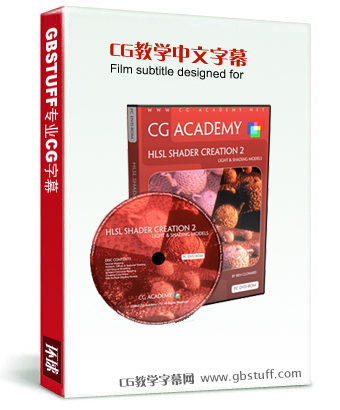| 本教学对应的中文字幕已经发布,请访问http://www.gbstuff.com/cg/productshopxp.asp?id=2667

在HLSL材质制作教学的第三张里面,BEN会告诉大家创建一个着色模型所需要的各种终极元素。教学包括了高质量的反射,折射,还有综合两者来制作水与玻璃材质。BEN还告诉了大家如何使用OFFSET MAPPING来加强normal maps,给到一种景深的效果。还包括了如何为normal map添加细节。如何在材质中添加顶点颜色与alpha值。还有如何只使用shader就让meshes的顶点动起来。本教学最终以一个动画的透明特效来做总结。
In this third tutorial in our HLSL Shader Creation series, Ben Cloward will show you had to create the final elements you will need for a complete shading model. This includes high quality reflections, refractions and combining both to create water or glass like materials using the Fresnel term. Ben will also show you how to further enhance your normal maps using offset mapping, giving the appearance of depth. Also how to add detail to your normal maps. How to use vertex colour and alpha values in your shaders. How to animate the meshes vertices using only the shader. And the series wraps up with an animated transparency effect.
This tutorial builds directly on the theory and coding skills taught in tutorials and one two in this series. We highly recommend you follow those tutorials before undertaking this. Or know the equivalent skills through your own previous learning.
CH01: Offset Mapping
Normal Mapping gives a strong illusion of a surface having more detail than it truly has. However, it does not give parallax, which makes a surface appear less three dimensional. In our first chapter Ben shows us how to implement Offset Mapping. Which gives the illusion of parallax. This makes surface features appear to have true depth.
CH02: Reflection Mapping
Reflections are a key part of any high quality lighting model. In pre-rendered 3D, reflections are taking over from the more traditional specular lighting models, such as Phong and Blinn. In this chapter Ben will show you how to implement Reflections and also how to blur them with no additional speed hit.
CH03: Creating a Metal Shader
In the previous chapter Ben demonstrated reflections that used a uniform level of blur. In this chapter he shows us how to create a Metal Shader, using maps to control which areas of a surface have blurred or sharp reflections.
CH04: Refraction Mapping
Transparent materials exhibit an effect where light rays are bent as they enter or exit that surface, distorting what can be seen beyond. This is known as Refraction. In this chapter, Ben shows us how we can implement this effect in our own shaders.
CH05: Using the Fresnel Term
In the real world, Reflections are not simple and uniform. Instead reflections tends to take place more readily as light glances off a surface at a shalow angle. This gives stronger reflections at the edge of spheres, as an example. In this chapter Ben shows how you can use the Fresnel term, that simulates this gradient of reflection, to better simulate transparent materials such as water, glass or diamond.
CH06: Detail-Normal Mapping
In the previous tutorial Ben showed us how to fade in more detail as you approach a colour map. In this chapter he shows us how to perform a similar effect with Normal Mapping.
CH08: Vertex Animation
A feature of HLSL shaders is that you can also deform the shaded surface using the shader. In this chapter Ben shows us how we can use this feature to produce animated deforming surface. A commonly used effect for cloth surfaces and water.
CH09: Animated Burn-Out Effect
And we wrap up this tutorial and the series as Ben shows us how to product a special shading effect, where a surface dissolves over time, using animated transparency, based on a maps alpha, and an edge glow using an IF statement.
|

